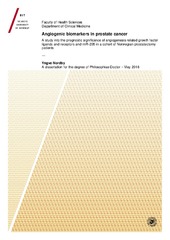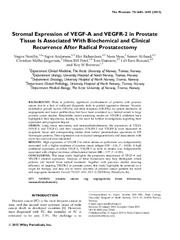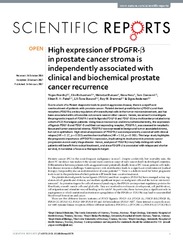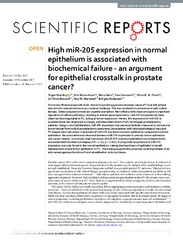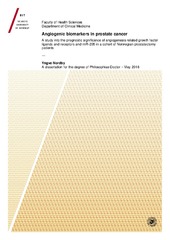| dc.contributor.advisor | Andersen, Sigve | |
| dc.contributor.author | Nordby, Yngve | |
| dc.date.accessioned | 2018-08-08T09:32:28Z | |
| dc.date.available | 2018-08-08T09:32:28Z | |
| dc.date.issued | 2018-05-03 | |
| dc.description.abstract | Background: Prostate cancer is a heterogeneous disease, ranging from indolent and slow growing, to aggressive and lethal. Due to insufficient prognostic tools, there is a significant overtreatment of patients with harmless disease. Differentiating which patients benefit from radical treatments remains a huge challenge, and there is an urgent need to find new and better prognostic tools that may aid in treatment allocation. Angiogenesis is a well-studied hallmark of cancer. Without sufficient blood flow, the malignant tumor cannot grow to a selfsustaining tumor of significant size. The prognostic impacts of selected angiogenic biomarkers in our cohort were explored, with the aim to uncover novel biomarkers to contribute to the knowledge of prostate cancer aggressiveness for improved risk stratification. In addition, a deeper understanding of the molecular characteristics and functional pathways for different stages in prostate cancer is essential in order to succeed in development of novel therapeutic agents for targeted therapy.
Methods: Patient data and prostatectomy specimens from 535 Norwegian patients treated for prostate cancer with curative intent were collected. Using tissue microarrays with several cores from predefined areas of the specimens, staining with immunohistochemistry and in-situ hybridization were performed for renowned angiogenic biomarkers. Correlations between expression levels of biomarkers and clinicopathological varibles were explored, event-free survival times were calculated according to expression levels, and to assess their independent prognostic impact, the markers were entered into multivariate analyses.
Main results: High expression of vascular endothelial growth factor receptor 2 (VEGFR-2) or vascular endothelial growth factor A (VEGF-A) was independently associated with a higher incidence of prostate cancer relapse. High stromal expression of platelet derived growth factor receptor β (PDGFR-β) was independently associated with clinical relapse and biochemical failure. High expression of microRNA (miR)-205 in normal epithelium was independently associated with biochemical relapse.
Conclusions: We found positive associations between prostate cancer relapse and several biomarkers associated with angiogenesis. Especially PDGFR-β seems promising as a new biomarker as it outperforms traditional established prognosticators. A common finding for all three papers was that the prognostic impact of angiogenic markers was mostly found in tissue outside the actual tumor epithelium, highlighting the complex interplay in prostate cancer tumors. This may have implications for tissue sampling for research and in a therapeutic perspective, these pathways may also be attractive targets for targeted therapy. | en_US |
| dc.description.doctoraltype | ph.d. | en_US |
| dc.description.popularabstract | Prostate cancer is the most common cancer in men in developed countries. While some develop to be aggressive and lethal, most forms of prostate cancer are indolent and slow growing. Due to insufficient prognostic tools, differentiating which patients benefit from treatment remains a huge challenge. This leads to a probable significant overtreatment of patients with harmless disease as many clinicians and patients don’t want to miss a chance for cure. There is an urgent need to find new and better prognostic tools to identify which patients really need treatment and which patients can be spared of the side effects of radical surgery or radiotherapy.
The formation of new blood vessels within a cancer tumor is crucial for the cancer disease to progress. In our study, molecules associated with blood vessel formation were measured in patients’ prostate cancer tissues. The appearances of the molecules associated with blood vessel formation were evaluated and compared to the patients’ course of disease. Interestingly, most of our studied biomarkers were only associated with cancer relapse when exploring the cells adjacent to the malignant cells (tumor microenvironment), namely in surrounding supportive tissue (stroma) or non-malignant prostate glands. This point to the importance of the tumor microenvironment in disease progression and the need for future studies to be sure of which prostate tissue they are sampling for research. The studied molecules can, if confirmed by other studies, be used as prognostic markers aiding treatment decisions and inhibition of these biomarkers or their pathways may be attractive targets for medical therapy. | en_US |
| dc.description.sponsorship | Avdeling for urologi og endokrin kirurgi, Universitetssykehuset Nord-Norge Hf | en_US |
| dc.identifier.uri | https://hdl.handle.net/10037/13370 | |
| dc.language.iso | eng | en_US |
| dc.publisher | UiT The Arctic University of Norway | en_US |
| dc.publisher | UiT Norges arktiske universitet | en_US |
| dc.rights.accessRights | openAccess | en_US |
| dc.rights.holder | Copyright 2018 The Author(s) | |
| dc.rights.uri | https://creativecommons.org/licenses/by-nc-sa/3.0 | en_US |
| dc.rights | Attribution-NonCommercial-ShareAlike 3.0 Unported (CC BY-NC-SA 3.0) | en_US |
| dc.subject | VDP::Medisinske Fag: 700::Basale medisinske, odontologiske og veterinærmedisinske fag: 710::Medisinsk molekylærbiologi: 711 | en_US |
| dc.subject | VDP::Medical disciplines: 700::Basic medical, dental and veterinary science disciplines: 710::Medical molecular biology: 711 | en_US |
| dc.title | Angiogenic biomarkers in prostate cancer - A study into the prognostic significance of angiogenesis related growth factor ligands and receptors and miR-205 in a cohort of Norwegian prostatectomy patients | en_US |
| dc.type | Doctoral thesis | en_US |
| dc.type | Doktorgradsavhandling | en_US |


 English
English norsk
norsk